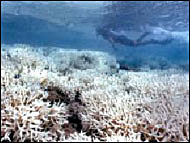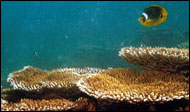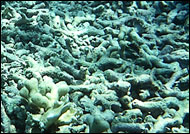Coral Bleaching |
 |
Coral bleaching is a stress response by symbiotic corals to a variety of environmental stresses that cause physiological imbalance between a coral and its symbiotic zooxanthellae. It can occur as a result of many stresses, such as sedimentation, pollution, shading and disease. Bleaching was first studied with respect to high temperature tolerance of corals in the 1970s, but it was not until mass bleaching of corals in the 1980s and 1990s due to global warming of sea waters and intense El Nino events that its significance to the survival of corals was realized.
 The term “bleaching” refers to the whitening of corals that is the result of expulsion of zooxanthellae from coral tissue, or loss of pigment in zooxanthellae that remain. Because most of a coral’s colour is related to the zooxanthellae and photosynthetic pigments, the white skeleton becomes visible through the transparent tissue. Under stress that causes mild bleaching, coral colonies usually survive and rebuild their internal zooxanthellae populations – by taking them up from the water, and/or by reproduction of ones in the tissue. However when the stress is severe, mortality of the coral often follows bleaching. It is not fully proven yet, but it appears that bleaching, by separating coral and zooxanthellae and shutting down photosynthesis in the symbiosis, may assist them to resist stressful conditions. If successful, the symbiosis is rebuilt after the stress has passed, and both partners have avoided mortality. When bleached, corals grow more slowly, as they do not receive an extra energy supply from the zooxanthellae, and they may be more susceptible to disease and other threats.
The term “bleaching” refers to the whitening of corals that is the result of expulsion of zooxanthellae from coral tissue, or loss of pigment in zooxanthellae that remain. Because most of a coral’s colour is related to the zooxanthellae and photosynthetic pigments, the white skeleton becomes visible through the transparent tissue. Under stress that causes mild bleaching, coral colonies usually survive and rebuild their internal zooxanthellae populations – by taking them up from the water, and/or by reproduction of ones in the tissue. However when the stress is severe, mortality of the coral often follows bleaching. It is not fully proven yet, but it appears that bleaching, by separating coral and zooxanthellae and shutting down photosynthesis in the symbiosis, may assist them to resist stressful conditions. If successful, the symbiosis is rebuilt after the stress has passed, and both partners have avoided mortality. When bleached, corals grow more slowly, as they do not receive an extra energy supply from the zooxanthellae, and they may be more susceptible to disease and other threats.
The mechanisms of bleaching are the subject of active research, as scientists try to understand the conditions under which bleaching does or does not occur, and when it is followed by mortality. Each factor that causes bleaching may act through different mechanisms, as a bleached coral is simply one with few zooxanthellae. The most dynamic area of current research is on temperature-induced bleaching (see below), as this appears to be the primary threat to corals and coral reefs since the El Nino-related coral mortalities of the 1980s, 90s and since 2000.
 Mortality of a coral colony following bleaching can be partial or total. If mortality is partial, then the remaining coral fragments may recover fully and continue growing after the hiatus during bleaching. Often their growth and reproduction will be impaired during and following bleaching, though within 1-2 years normal function is usually possible.
Mortality of a coral colony following bleaching can be partial or total. If mortality is partial, then the remaining coral fragments may recover fully and continue growing after the hiatus during bleaching. Often their growth and reproduction will be impaired during and following bleaching, though within 1-2 years normal function is usually possible.
Cellular mechanisms of bleaching
The photosynthetic function of symbiotic zooxanthellae is impaired under high temperature and lights conditions. The most population hypothesis at present is that on the onset of thermal stress, there is a reduction in the activity of photosystem II (PSII) in the zooxanthellae chloroplasts. Two possible mechanisms are direct damage of PSII itself and impairment of the dark reactions of photosynthesis, both by impairment of proteins and enzymes critical to their function. Effectively, this causes a breakdown in the ability of the photosynthetic apparatus to pass excitation energy collected by PSII, transform it into fixed products (lipids) and dissipate the excess harmlessly. Photopreotective mechanisms, that include xanthophyll pigments are apparently overwhelmed during thermal stress, leading to chronic or long-term damage. Photosynthetic light, including both visible (Photosynthetically Active Radition – PAR) and ultraviolet (UV-A and UV-B) during increased thermal stress increases the damage associated with this stress.
Following breakdown in the photosynthetic apparatus during bleaching, oxidative stress is proposed as the next step in the chain reaction. The different sites of damage (PSII or dark reaction) both result in toxic oxygen radicals being produced in excess of normal photosynthetic rates, thus overwhelming the enzyme systems of both zooxanthellae and coral tissues designed to manage these. Oxygen radicals cause damage to cellular components within the coral, thus bleached corals and those approaching a bleached state are likely already suffering cellular damage.
(see Iglesias-Prieto et al 1992; Warner et al. 1996,Jones et al. 1998, Lesser et al 1992, Salih et al. 1997a)
Zooxanthellae
Scientists have now found that there are many different types (probably species) of zooxanthellae (in the genus Symbiodinium), and that coral species and zooxanthellae types or classes vary in how specifically they are associated together. Just as corals have different tolerances to stress and life history strategies, the zooxanthellae types also differ – and some are more resistant to bleaching than others. Zooxanthellae exhibit profound physiological differences, including sensitivity to thermal and light stress, capacity to dissipate excess excitation energy, protection mechanisms against UV radiation, and stability of the photosynthetic membrane. Likely because of their different physiological properties, zooxanthellae types have varied distributions geographically, by habitat and depth within reef systems and even within coral heads. Five primary clades have been found, with increasing numbers of subordinate taxa as techniques improve; clades A and B predominate on high latitude coral reefs, while clade C and D are usually found on low latitude coral reefs. Additionally, some clades are differentiated by whether they are found in tissue on the tops or sides of coral colonies. The differences among zooxanthellae may explain why different levels of bleaching in corals are observed among reefs, habitats and even among colonies of a species in a uniform habitat, and between different tissue orientations within a colony. Repopulation of zooxanthellae into a bleached coral might also result in different population of zooxanthellae.
(see Rowan et al. 1997; Loh et al. 1997, Baker 2001)
Ecological implications of bleaching
 Coral bleaching, if it results in widespread mortality of coral colonies, and in particular, near-total mortality of vulnerable species, represents a significant threat to coral reefs globally. The recovery of a reef community after a bleaching event depends on the extent to which remaining corals can grow and reproduce, inputs of new larvae from other reefs, and rebuilding of the ecological functions provided by the original coral community and associated flora and fauna. In the words of resilience theory, bleaching may represent a massive perturbation of a reef community from its coral-dominated stable state to one in which recovery to coral dominance is not possible, or too slow. Under these conditions, the ecosystem may shift to another stable state, such as an algal-dominated reef, with permanent loss of the ecosystem goods and services provided by the coral reef.
Coral bleaching, if it results in widespread mortality of coral colonies, and in particular, near-total mortality of vulnerable species, represents a significant threat to coral reefs globally. The recovery of a reef community after a bleaching event depends on the extent to which remaining corals can grow and reproduce, inputs of new larvae from other reefs, and rebuilding of the ecological functions provided by the original coral community and associated flora and fauna. In the words of resilience theory, bleaching may represent a massive perturbation of a reef community from its coral-dominated stable state to one in which recovery to coral dominance is not possible, or too slow. Under these conditions, the ecosystem may shift to another stable state, such as an algal-dominated reef, with permanent loss of the ecosystem goods and services provided by the coral reef.
On the massive scale recorded during the El Niño of 1997-98 then with repeated smaller regional bleaching events that have been documented in the subsequent years, this may eventually result in regional and global loss of coral reef ecosystems on a scale that will be impossible for coral reefs to maintain the large scale processes of connectivity and genetic exchange required to keep them in their present state. Predictions of the future of coral reefs vary from apocalyptic to hopeful, depending on assessment of the speed of climate change and the ability of corals and/or zooxanthellae to evolve in response to the changing conditions.
(see Glynn 1993, Brown 1997, Hoegh-Guldberg 2001, Hughes et al. 2003)
